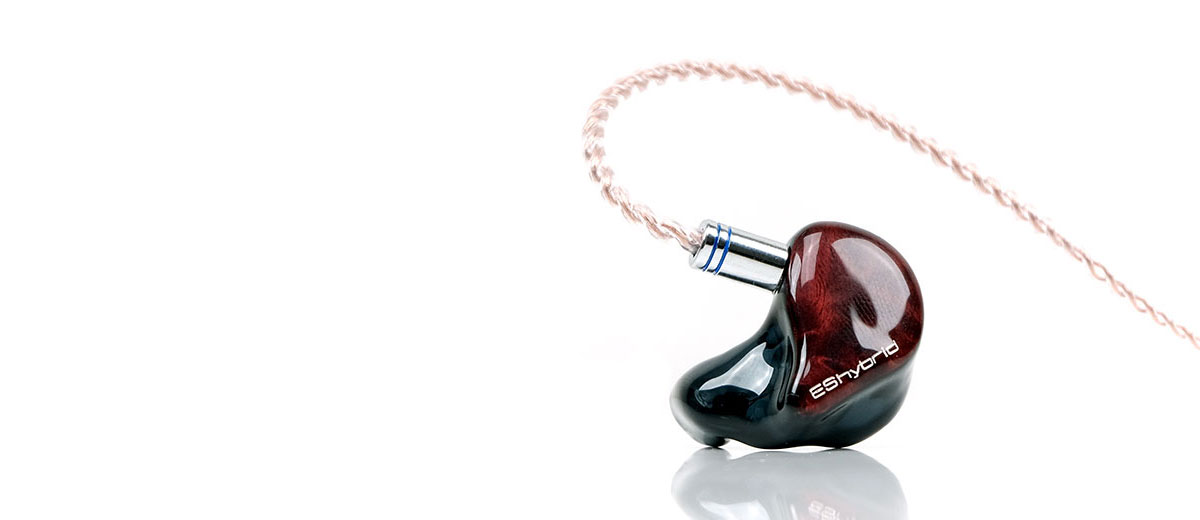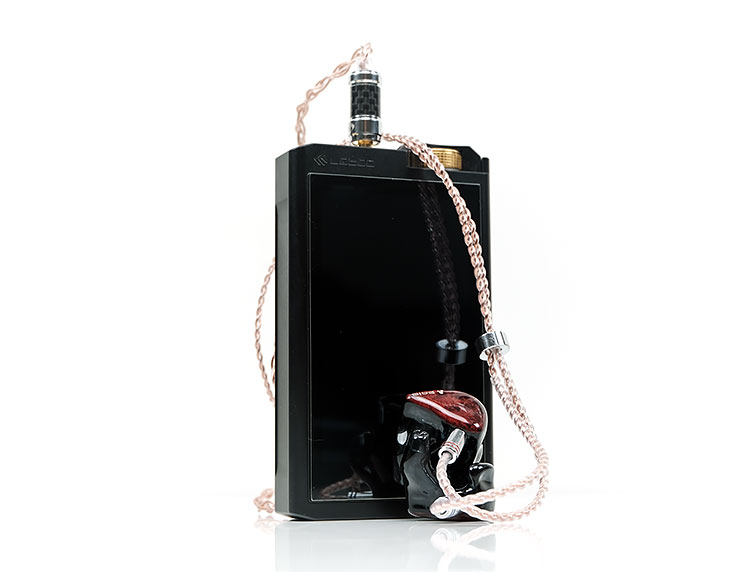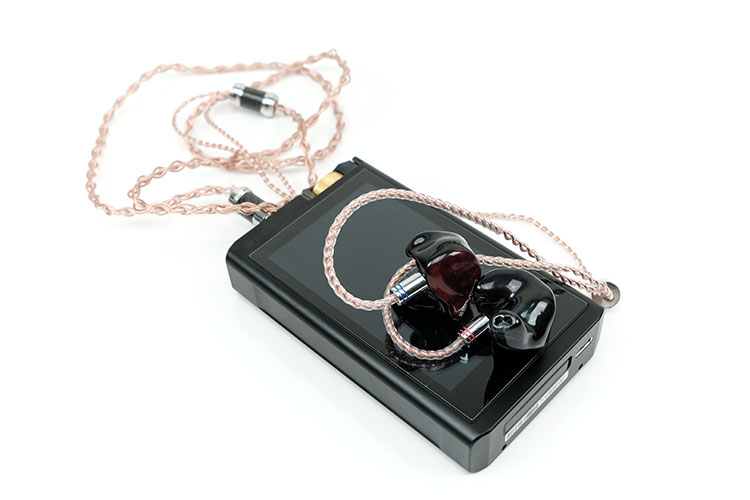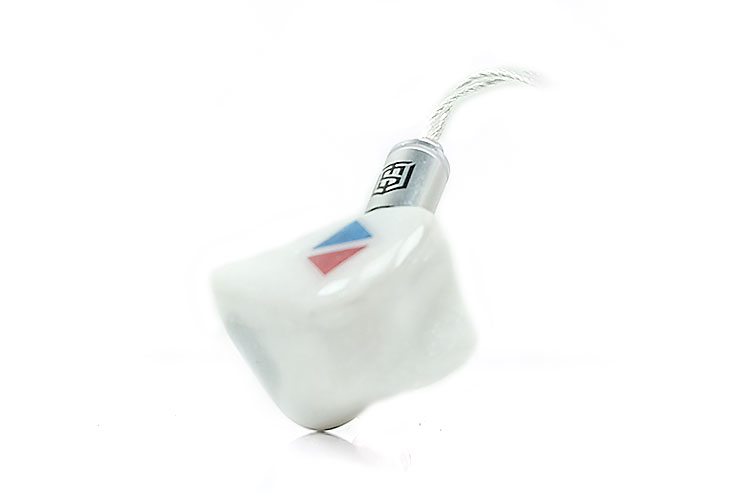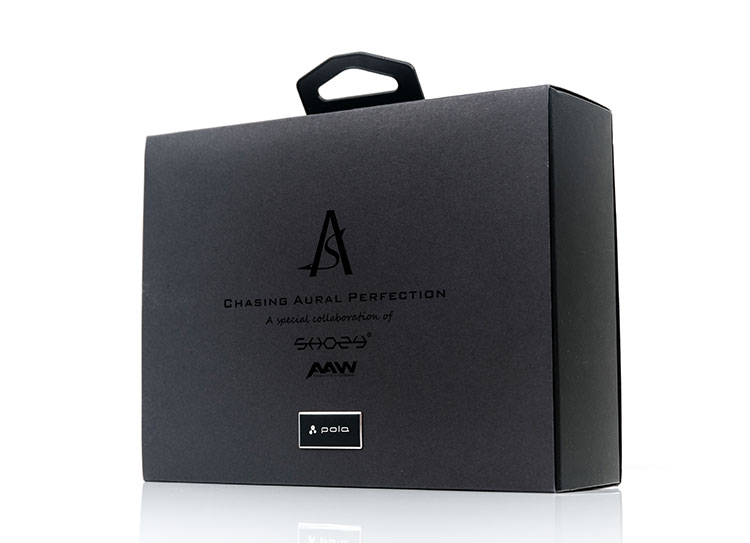Sound Impressions
Summary
There are advantages in some respect to forgoing any balanced armatures in a hybrid design such as this. With a crossover point at around 6-7k, you get the natural coherence and balance of a single large dynamic driver for a good portion of the POLA’s frequency response.
To call the low-end flat would be slightly misleading, however. There is a natural sub-bass bias in its low-end performance but it is more subtle than stark at around 2-3dB and then a gentle and somewhat linear drop to 1k.
The lower-mids are not that scooped out, not as much as the Khan or Trinity so it carries a little warmth with it into the lower mids for a natural sounding timbre. The mids have a great vocal presence but also a 2-4k dip that for some pitching can push it back a little further than those stats hybrids with a BA midrange.
Treble on the POLA is excellent and quite neutral in its positioning in the context of the more aggressive Noble Audio Khan but a little more forward than the Jomo Audio Trinity. It has a solid tone to it, with good body and a little peak around 4-5k and once again around 8k where the stats drivers take over. That gives it an airy tone but not a lean peaky sound that some BA drivers tend to veer into when pushed forward.
Staging
The POLA has excellent depth and a superb airy top-end with great headroom. Despite the excellent vocal presence, it is not an overly intimate soundstage. There is a bit of a dip at 2-4k that can throw a tiny veil over the performance compared to the more vivid and focused BA designs of the Khan and the Trinity. You are shooting for scale here rather than absolute resolution.
Yet, the low-end is very natural and clean sounding to my ear right down to the sub-bass performance. Such is the way of things when you use powerful large dynamic drivers over all-BA or smaller alternatives.
Bass
A very enjoyable but well-controlled bass delivery. The POLA has a very slight sub-bass lift and a gentle linear drop to 1k. A good tuning for me personally because that bass fundamental in power pitched instruments is strong without having to add huge amounts of mid-bass warmth. Yet there is just enough warmth creeping into the lower-mids to deliver a very natural instrumental timbre so its nothing lean or lacking in weight.
The pace is decent also for a dynamic driver, it does not sound sluggish but it does have that natural level of decay so not quite as pacy as a BA variant. You do however get excellent texture and layering in its delivery and the tuning does contribute to a nice open sound.
Mids
Lower-mids from 500Hz to 1k have a very subtle dip but nothing huge. The POLA then takes a fairly pronounced 1-2k rise before it dips from 2-4k. Percussion is very natural sounding to my ear on the Pola with a nice harmonic balance and an accurate timbre. Depending on pitching vocals on the POLA will either sound very focused and beautiful or they can struggle just a tiny bit for air with that more elevated lower midrange.
If the instrumental layering is fairly sparse or stripped down the vocal sound fantastic without a hint of sibilance in either male or female vocals. Throw on a ton of lower mids instrumentals or strong guitar work then some vocals can lose their way a bit.
Tracks such as Danny Hutton Hitter’s version of Nik Kershaw’s ” Wouldn’t It Be Good” have the perfect blend of light instrumental layering and a strong AOR-type male vocal delivery that provided for an absorbing listen on the Pola. However, Arch Enemy’s Alissa White-Gluz and her guttural death growls did not quite have the presence and clarity I would normally look for once Amott and Loomis’s twin guitar attacks get to work.
Treble
In some ways, it is the star of the show, this is all about the stats drivers after all. They kick in around 8k to give the POLA some solid headroom, plenty of sparkle and air without ever sounding annoyingly peaky or lean.
There is a peak just as you hit the lower treble to prevent the presentation from sounding muted and dull and then that more prominent 8k elevation. It is articulate, sometimes effortless and never harsh sounding. The speed of these drivers is excellent by the way.
I can well expect AAW and Shozy to tell me just how hard it was to blend in the pace of these drivers with the slower dynamic driver delivery to get the phasing just right. Good amping power really helps keep a lid on the POLA treble also. I love how it sounds from the Lotoo PAW Gold Touch with its 0.5W into 32Ω power and very clean and open delivery.
Matchability
Efficiency
The POLA is rated at 16Ω and 10dB SPL. It is not the hardest to drive so voltage is not the issue however it will require decent current to get it to optimal volume levels and it is one of the harder stats IEMs, alongside the Trinity, in terms of gain. The Noble Khan and Soranik’s new D.E.S. BA stats flagship are much easier to push up the juice by around 10dB compared to the POLA.
Working a test trio of the R6 Pro, Sony’s 1Z and the Lotoo PAW Gold Touch we found all of them could easily drive the POLA but the volume was quite high in some cases up to 30 steps higher than the D.E.S. BA stats driver from Soranik on the Gold Touch (92 vs 65 unbalanced low gain).
You could stick the POLA in high gain and get away with it on the Touch and for sure the Sony 1Z might be a happy camper in a high-gain mode when paired with the POLA. The R6 Pro has more than enough power and current to drive the POLA.
Given the low SPL (101dB) you will have no issues with high noise floors and background hiss with most sources. The three sources mentioned above delivered nice backgrounds and not a hint of hiss.
Synergy
Power and clarity. Despite the 16Ω rating, we found the Pola was optimal with a neutral source with a strong emphasis on clean, clear and detail presentations.
Surprisingly, the Sony 1Z didn’t do it for me with the Pola compared to the more reference and neutral sounding Lotoo PAW Gold Touch. The LPGT has more power and a cleaner signature. It might not be as punchy as the Sony 1Z but for some reason, the mids didn’t sound as dynamic or as open as the Touch with the Pola. I suspect the POLA can scale as most good quality dynamic drivers can do when given a quality signal.
The R6 Pro has some nice body when paired with the Pola and delivered a relatively smooth and balanced sound but didn’t quite have the openness and air of the LPGT or the punchy low-end of the 1Z. You could argue it was an in-betweener of sorts though accepting its brilliant MSEB DSP can tweak that to a much cleaner sound if you prefer.
I would give a slight edge to the iBasso DX200 with the Amp 1 card for sub-1k DAPs and the POLA. It has a cleaner sound and a bit more treble articulation with the Pola that sounds just right for me. There is also zero SPL problems with that very powerful Amp 1 card.
Select Comparisons
Soranik DES
$1250
Technical
The ‘D.E.S.’ is more of a working title for what could well be the dark horse of this new stats hybrid market. This is a Vietnamese company in case you are hearing the name for the first time but have quite a wide range of IEMs up until this point such as the SK1 and YK1.
The D.E.S. is a big statement with no less than 8 BA drivers and dual stats super-tweeters. The configuration is 4 for the lows, 2 for the mids, 2 for the highs and the stats on top of that. All of this is packed into a true 3-way Crossover with 3 separate cutoffs. There are no dynamic drivers in the D.E.S. compared to the POLA which has no BA drivers.
No other technical data exists at this time concerning SPL and impedance, we will likely know in the next few weeks as we continue our dialog with the team at Soranik.
Build
Build-wise this is a universal IEM and comes in an all-white finish. It is substantially smaller than the POLA given it does not have to fit a large dynamic driver inside. The fit is comfortable with a custom universal curved design though the isolation is not as good as the custom POLA.
Like the POLA, the D.E.S. also uses 2-pin recessed sockets though the stock cable is nowhere near as good as the 48″ Tiburon supplied with the POLA.
Performance
I may not know the final SPL and impedance numbers just yet but I can tell you the D.E.S. is far more efficient than the POLA. I suspect the SPL is the main factor here with the POLA at a not very efficient 101dB. The Soranik took a good 20 steps less than the POLA on low gain using the Lotoo Touch. This puts it around +10dB more efficient and around -110dB SPL (we will confirm this if we can).
I can also tell you that the D.E.S. is not as efficient as the Solaris or Andromeda taking around 3-4 steps more on low gain 3.5mm using the R6 Pro from HiBy. You will hear no hiss from either the D.E.S. or the Pola on the R6 Pro, Lotoo Touch or the Sony 1Z in case you are worried about noise floors.
Tuning
It is early days for us with the D.E.S. tuning so this is by no means a final assessment (First Contact and full review soon). For me the D.E.S. has a bit more mids-focus with a more classic BA feel to the low-end. It is punchy with more low-end quantity but does not have that natural decay or quite the same level of texture and detail at the lowest level compared to the Pola’s big graphene driver.
The D.E.S. sounds a little more intimate and a bit more euphonic in its instrumental timbre and voicing. It is not quite as open or as grand sounding as the POLA. Vocals on both seem to have similar positioning just a slight difference in the tuning with the D.E.S. a little warmer and softer and the POLA a little more neutral and cleaner sounding.
The treble tuning is also a bit more on the relaxed side and of the three compared could be considered the most relaxed presentation. It does not have the same level of air and sparkle as the Pola but it does have a bit more body in its lower-treble timbre and a slightly wetter sound.
Noble Audio Khan
$2399
Technical
The Khan is a ‘tri-level’ hybrid universal monitor from Noble Audio and it is their current flagship IEM at the time of writing. It consists of a total of 6 drivers. The first two blends are the ‘familiars’ as I like to call it; a single 10mm dynamic driver and 4 balanced armature drivers.
The final two are piezoelectric drivers which are slightly different from POLA’s Sonion electrostatic drivers. The main difference between the two is that piezoelectric transducers use a ceramic material whereas electrostatic transducers contain a thin metal membrane. Both rely on the ‘piezoelectric effect’ in order to function.
Performance
The Khan rating is a little unknown at this point. Noble never really like to discuss numbers so we tended to rely on just good old basic volume matching for SPL numbers. We do know that quite a lot of the time Noble BA designs are around 30Ω but given this hybrid fusion, it could be anything from 16Ω to 30Ω.
We did, however, find the Khan to be more efficient than the POLA. With the R6 Pro unbalanced we had the Khan quite comfortable around 28-32 steps and the POLA much higher at 45 steps.
Given the 101dB of the POLA, it is likely the Khan is roughly around the 110dB marker. Both have nice black backgrounds on higher noise floors such as the R6 Pro and the FiiO X5iii. These two have low enough SPL’s to avoid that concern on most sources.
Tuning
If the Trinity is a little laid back in the stats treble tuning and the POLA is more neutral then the Khan could be described as being the most forward sounding of the three for stats quantity and presence. The more forward treble presence also injects a little more upper mids percussion ‘bite’ on the Khan over the Pola.
The other major difference is in the mids tuning. I do like the clarity and balance of the Khan’s midrange a lot and you do get a lot of nuanced detail from those balanced armature drivers. The POLA is a little more dipped in the mids around 2-4k though vocal presence but not quite as resolving in the mids as the Khan’s 4BA tuning. The POLA’s timbre is a little softer and smoother than the Noble flagship’s ultra-clean and feisty midrange performance.
The larger DD of the Pola has a bit more warmth and body than the smaller Khan dynamic driver. The Khan low-end has a bit more lower-mids scoop whereas the Pola’s retains a bit more mid-bass and lower mids warmth and body. Both have good sub-bass extension and presence so no issues on staging depth.
Jomo Audio Trinity
SG$3,799.00
Technical
Like the Khan, the Trinity is another tri-level hybrid universal monitor with dynamics, BA and stats all fused into one shell. There are 7 drivers in total with a single 8mm dynamic driver for the lows, 4 balanced armature drivers for the mids and highs and 2 electrostatic super tweeters.
The Pola custom has a bigger graphene dynamic driver and a Dual Electrostatic Super Tweeter design. It does not use any BA tech like the Trinity or the Khan but it does have the largest dynamic driver of the three monitors compared. There is a passive two-way crossover to integrate both sets of drivers using AAW’s TrueXross technology.
Performance
The Pola is rated at 16Ω and 101dB SPL. In our testing we found the Pola to be fairly inefficient but not quite hard to drive as the Trinity. Both will not require huge amounts of amping but they do need quality amping with decent headroom to sound at their best.
The gap between the two is certainly much smaller than compared to the Khan. The Sony 1Z sat comfortably around a volume of 95-100 in low gain compared to 105 with the Trinity. On the Aroma Audio A10 portable amp with the Lotoo PAW Gold Touch line out the difference was marginal with almost no adjustment required at all (both around 11am).
Both will have no issues with any highish noise floors from portable amps and DAPs and will offer a quiet performance on the HiBy R6 Pro, DX200/150 with Amp 8 and the FiiO X5iii.
Tuning
The Trinity Brass is a little more musical and smoother to my ear than the Pola. That is not to say the Pola is a lifeless affair, far from it. Rather, the Pola presentation is a little more neutral and definitely more linear sounding in the low-end.
As a result, the Trinity will sound the slightly warmer of the two with more mid-bass physicality. It will hit a little harder though I must give props to the Pola, the definition right into the sub-bass is excellent. You get a bit less quantity and mid-bass bloom in exchange for a very coherent reference type bass response.
The Trinity also has a bit more detail in its instrumental texture with those four BAs covering the mids and highs. Higher pitched vocals on the Trinity Brass are further forward and slightly richer sounding. The Pola is a little cleaner in vocal timbre and more neutral in positioning but there is less of a lower mids dip so lower pitched male vocals have a bit more body on the Pola.
Now if you switch to foams on the Trinity you will soften up the signature a bit more and dial down those stats tweeters to a fair degree compared to the Pola. The Pola custom tweeter tuning has a bit more presence than the foam Trinity Brass presentation, however, the Whirlwind tips bring plenty of treble presence back.
Our Verdict
The POLA sound will be unique to some with those stats drivers bringing in a strong but never harsh treble overture. The sparkle and air provided by these drivers make a qualitative difference to the treble tone that some BA drivers genuinely struggle with.
The omission of an even more complex midrange BA driver design does help to keep the sound fairly coherent and balanced but some might miss the mids presence and details of those hybrids that use them. It can be a preference thing at times but the tuning is impressive nonetheless.
What you also need to know is that that graphene dynamic driver tuning is excellent. This is not overcooked or overly warmed up, it reaches deep and sounds satisfyingly natural and powerful to my ear. It can also scale despite the 16Ω rating. I recommend either the DX200 with Amp 1 or the Lotoo PAW Gold Touch, keep it neutral but with good power.
To be perfectly honest I am delighted with the performance to price proposition of the POLA and kudos to Shozy and AAW for keeping the SRP below 1k. They could so easily have slapped on another 1k and called it their flagship and some would have been none the wiser because it sounds really good indeed.
POLA Technical Specifications
- DUAL crossover, vented design for optimized dynamic driver performance
- 10Hz-100000Hz mega wideband performance
- <0.5% Total Harmonic Distortion
- 12 Ohm low impedance
- Dual bore design
- 13mm graphene dynamic driver
- Dual electrostatic tweeters
- Impedance: 12Ω
- SPL: 101dB
- Specification and internal parts for Custom Version is slightly different to accommodate changes when switching from universal to custom housings

